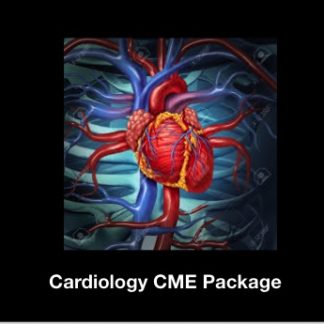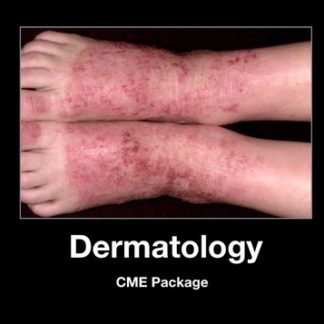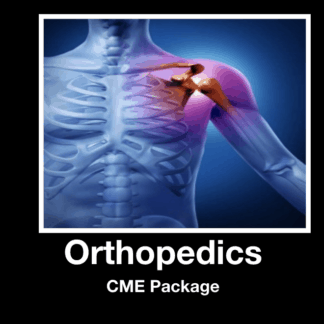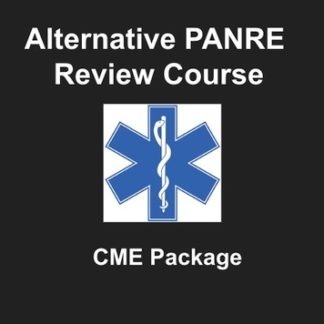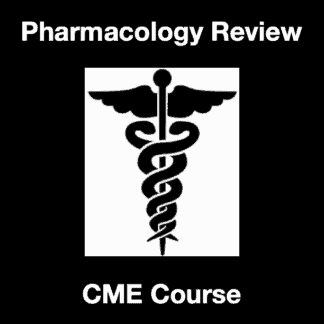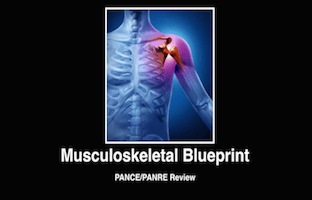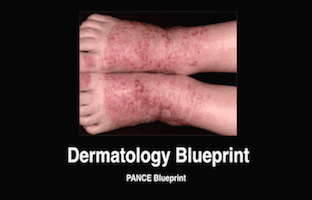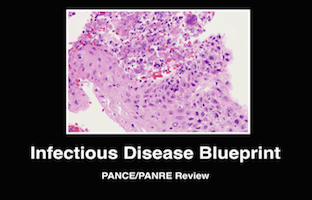Description
Musculoskeletal PANCE/PANRE Review Course and Video
This section is review of the Musculoskeletal Section for the NCCPA Blueprint topic list for the PANCE and PANRE. This section contains the Musculoskeletal Lecture Video (2:32:38), as well as 131 Musculoskeletal Multiple Choice PANCE style questions, answers and detailed explanations from this section. Musculoskeletal Lecture Slides are also included. This Musculoskeletal section will be continuously updated and you will be given access for 30 months.
This section is designed for physician assistants preparing to take the PANCE/PANRE. Medical students preparing for the USMLE and COMLEX may find this section helpful.
We do offer Category 2 CME with Amazon and Apple Gift Cards. Click here if interested in CME with Amazon and Apple Gift Cards
This is in a mobile friendly form.
Musculoskeletal Blueprint Preview Questions, Answers and Detailed Explanations
Musculoskeletal Blueprint
Questions, Answers, and Explanations
Questions 1
1. A 54 year old right-handed male presents to you two days after a fall onto his outstretched right arm. He slipped at work and attempted to brace his fall. He has moderate pain in his shoulder that increases with attempts to lift his arm. He states that he cannot lift his arm above his head. On examination you notice some ecchymosis over the lateral shoulder. Your patient can forward flex his shoulder to about 60 degrees. Surprisingly, he has good strength with a liftoff test for internal rotation. Plain films of his shoulder are negative for fracture/dislocation. Based on this information, what injury do you suspect your patient has?
A. A tear of his subscapularis tendon
B. A shoulder dislocation-relocation
C. A tear of his supraspinatus and subscapularis tendons
D. A tear of his supraspinatus tendon
E. An isolated infraspinatus tendon tear
Answer 1
1. Choice D is the correct answer. The rotator cuff is made of 4 muscles: supraspinatus, subscapularis, infraspinatus, and teres minor muscles. The supraspinatus abducts the humerus. The infraspinatus and the teres minor muscles externally rotate the humerus and the subscapularis internally rotates the humerus.
Question 2
2. A 19 year old right-handed male university student falls onto his right outstretched hand. He presents acutely to you for pain on the thumb side of his wrist. No prior injury. He has pain in his anatomic snuffbox. Plain films of his four view right wrist are negative for fracture. What treatment should you offer this patient?
A. Place him in a short arm thumb spica splint for 7-10 days and repeat x-rays.
B. Put the patient in a long-arm cast for three weeks, then repeat x-rays of wrist and scaphoid
C. Put the patient in a sugar tong splint for four weeks then get repeat x-rays out of the cast
D. Get a bone scan and if positive, treat the patient in a short-arm thumb spica splint for four to six weeks
E. Get an MRI of his right wrist and if positive, treat the patient in a long-arm thumb spica cast for four to six weeks
Answer 2
2. Choice A is the correct answer. This patient has an injury concerning for a scaphoid injury/fracture. All suspected scaphoid injuries should acutely with a thumb spica. Scaphoid fractures not managed appropriately can result in osteonecrosis or non union. Because the blood supply of the bone is poor, it enters the scaphoid through the distal third of the bone.
Question 3
3. While working in the emergency room during phase II you see an 11 year old girl with left arm pain. She fell from a swing and has moderate arm swelling. Radiographs show a short oblique fracture of her humeral shaft. Which abnormal neurologic examination finding is most commonly seen with this injury?
Weak wrist pronation
Weak small finger abduction
C. Weak thumb extension
D. Froment sign
E. Decreased sensation over palm of hand
Answer 3
3. Choice C is the correct answer. Humeral shaft fractures can cause radial nerve injury. This would present as difficulty to extend the wrist or fingers, and loss of sensation on the dorsum of the hand. Froment sign is a test to detect ulnar nerve palsy, specifically the action of the adductor pollicis.
Question 4
4. A 27 year old left-handed lady complains to you about two weeks of left wrist pain. No trauma or surgery. She is a mother of two children, ages three and eight months. She has pain over her first dorsal compartment tendons and a positive Finkelstein’s test. Plain films of her wrist are normal. What is the diagnosis?
A. Flexor carpi radialis tendonitis
B. Wrist arthritis
C. Occult scaphoid fracture
D. Extensor pollicis longus tendonitis
E. De Quervain’s tenosynovitis
Answer 4
4. Choice E is the correct answer. De Quervain’s tenosynovitis presents with pain in the dominant hand not the extensor side of the dominant thumb. Patients have a history of repetitive motions and have a positive Finkelstein’s test which is pain along the extensor surface of the thumb with flexion of the thumb at the MCP joint.
Question 5
5. A 23 year old right-handed male legal technician presents to you for pain in his left thumb after a skiing injury. His thumb was extended during a fall one week ago. He has taken Motrin for the pain and applied ice for swelling. You examine his left thumb metacarpophalangeal joint and find minimal joint opening with stress and a positive endpoint. X-rays are negative. What is the best treatment for this patient?
A. Referral to orthopedics for possible surgery
B. Buddy taping to index finger for two weeks then start range of motion
C. Splint metacarpophalangeal joint in 20-30 degrees flexion for 2-3 weeks
D. Short-arm thumb spica cast for four weeks
E. Long-arm thumb spica cast for 6-8 weeks
Answer 5
5. Choice D is the correct answer. This patient has Gamekeeper’s thumb which is laxity of the ulnar collateral ligament at the interphalangeal joint of the thumb. This patient needs a thumb spica and immobilization initially. If she fails, she may require repair of the ligament.
Question 6
6. A 13 year old male high school cross-country runner presents to you for bilateral anterior knee pain. This pain has developed over the past two months after he joined the team. He wants to compete but the pain will not allow him to run more than twice a week. He has prominent tibial tubercles and radiographs confirm heterotopic ossification anterior to the tibial tuberosities. What is the best treatment for this patient?
A. Discontinue sport, and re-evaluate after a month.
B. Wear bilateral patella sleeves for support, rest for 2-3 weeks then resume running
C. Refer to orthopedics for bilateral long leg cylinder casts
D. Physical therapy for quad strengthening, no running for 3-4 weeks
E. Cho Pat knee straps, rest, ice, and Motrin 800mg before running; no change in cross-country participation
Answer 6
6. Choice A is the correct answer. This patient has Osgood Schlatter syndrome. The best initial approach is to eliminate the activity likely cause the irritation and give the family reassurance.
Question 7
7. A 22 year old female college student is involved in a motor vehicle accident. She sustains a closed posterior right hip dislocation. Plain films and a CT scan do not reveal a fracture. She has good distal pulses and motor function in her right lower extremity. Why is this case considered an orthopedic emergency?
A. Missed fragments can make relocation of the hip difficult
B. The risk of osteonecrosis increases with delayed reduction
C. Neurovascular structures are at risk for injury
D. Occult fractures of the femoral neck are common
E. The young age of the patient
Answer 7
7. Choice B is the correct answer. Dislocation of the hip tear the hip capsule and alters blood supply to the femoral head. Delay in reduction therefore can lead to osteonecrosis. Missed fragments or occult fractures of the femoral neck would have been detected with the hip CT scan. The patients young age has nothing to do with the need for reduction of this hip.
Question 8
8. Which treatment is considered a disease-modifying agent used in the management of rheumatoid arthritis?
A. Naprosyn
B. Splints
C. Oral steroids
D. Methotrexate
E. Injected steroids
Answer 8
8. Choice D is the correct answer. The class of medication that methotrexate belongs to is called DMARDs (Disease Modifying Anti-rheumatic Drugs). Naprosyn, oral steroids, and injected steroids can also be used in the treatment of RA.
Question 9
9. A 13 year old female presents to you for complaint of left, lateral knee pain for two months. She feels a sharp pain and hears a pop with knee extension. These symptoms occur once daily but the pain lasts for almost an hour before she is able to resume regular activities. On examination your patient does not have an effusion, passive motion from 0-120 degrees flexion is smooth, but you hear a click along her lateral joint line. What is the most likely diagnosis?
A. Lateral collateral ligament sprain
B. Discoid meniscus
C. Anterior cruciate ligament sprain
D. Osteochondral defect of the medial femoral condyle
E. Patellofemoral syndrome
Answer 9
9. Choice B is the correct answer. Meniscal tears usually present with click with flexion. This is a positive McMurray. Lateral collateral ligament strain and ACL strain may have some laxity with those ligaments.
Question 10
10. A 42 year old lady comes to you for advice regarding chronic left foot pain. She has no idea why her foot began hurting. Symptoms consist of an ache like pain that increases while walking on the bottom of her heel. Her most intense pain occurs in the morning, attempting to take those first few steps of the day. On examination she has pain over the plantar medial calcaneal tuberosity. What is her diagnosis?
A. Retrocalcaneal bursitis
B. Calcaneal stress fracture
C. Plantar fasciitis
D. Plantar fibroma
E. Tarsal tunnel syndrome
Answer 10
10. Choice C is the correct answer. Patients report pain usually 1-2 cm distally along the calcaneal tuberosity. The patients complain of pain usually in the morning when the wake up and step on a hard floor without shoes and this stretches the plantar fasciae. The patient’s pain is usually alleviated with rest. Tarsal tunnel syndrome is more of a burning and paresthesias that occur on the medial aspect of the ankle and foot. Plantar fibromas usually only give pain in the area of the lesion.
